Demographics & Technology Continues To Change Retailing
|
|
Around Halloween each year I think more and more about retailing. Not because I’m into mass consumerism, but because of the five years I spent working at Toys “R” Us (1983-87). I also briefly worked at Dillard’s for a few months in 1988. Architecture school became too demanding, so I stopped working my last two of five years in college. In architecture school I took an interest in retail design.

Growing up in the 1970s, retailing was represented by Sears, Montgomery Ward (their catalogs too!), and Oklahoma stores like C.R. Anthony, TG&Y, Otasco, etc. Looking back on my personal experience, I realize just how much retailing has changed in my almost 50 years. My parents & grandparents saw considerable change in retailing during their lifetimes (1886-2007 range).

Today we have our phones out when in brick & mortar retail stores. I use a grocery app daily — I’ve added non-grocery stores for other items as well. Recently, in Target, we saw the Elf on a Shelf and decided to finally get it. A quick scan of barcode within the Amazon app showed us the price was the same at both stores, so we bought it at Target. We paid sales tax by buying at Target, but we got 5% off by using our Target RedCard MasterCard. However, we’re currently getting 5% cash back through Amazon using our Discover card. We paid more — the amount of sales taxes — so we could have it immediately. An informed decision.
My experience at Toys “R” Us was very different. I stocked shelves, but also worked as a cashier. Though part-time, I became a head cashier that trained and supervised other cashiers. In those days we had to key in a 6-digit stock keeping unit (SKU) for every item — no scanning a barcode. The register knew the price — assuming the price sticker on the product and computer were both updated. After we had the total sale amount we’d fill out a credit card form and do an imprint of the card on the form. We had to enter the card number into the register to get an authorization code, which was then written on the form.
The truth is that the credit card imprint is nothing new. That’s how all transactions were handled in the days before the magnetic strip. It seems silly to have to explain this, but believe it or not, there are these imprint machines that are entirely mechanical. The merchant places the card on a steel plate on the imprinter and a credit card form is placed over it (it used to have “carbon paper” for those old enough to remember). The merchant slides an arm over the whole thing, and the pressure from the arm imprints the raised numbers on your card onto the paper form. It contains all the important information, such as card numbers and expiration date. (NerdWallet)
My point is retailing has continuously evolved since the first retail transaction. Once-giant retailers, like Sears, barely survive today. Some mom & pop stores go out of business, while others grow to become Nike, Spankx, Whole Foods, etc. With Millennials outnumbering Baby Boomers and Gen-Z shoppers entering the picture you can expect retail to continue changing.
Amazon is trying to stay ahead of these changes. As Amazon Prime members we’re used to getting things in two days, very fast compared to the old days of pre-internet mail/phone order from catalogs. But sometimes you can’t wait 2 days. Google Express offers next-day delivery from local stores in St. Louis, with same-day delivery in some markets. Very soon Amazon will open two huge facilities in the Metro area — from June:
Online retail giant Amazon announced Thursday that it would build two distribution centers in Edwardsville, bringing 1,000 new jobs and adding a big name to a growing distribution and logistics hub in the Metro East.
Known as “fulfillment centers,” the Amazon warehouse and distribution facilities service a growing cadre of online shoppers by storing and shipping goods to consumers who want them fast. One center will handle large items — big screen TVs, sports equipment or kayaks — while another will handle smaller items such as books and electronics.
Amazon has about 50 of the centers, and as online retail competition grows, the company is looking to meet the fast delivery times promised by its premium service, Amazon Prime. (Post-Dispatch)
How fast? Try 2 hours, or 1 hour for an additional fee!
We’ll be in Chicago for four nights in mid-February, so I’ll try Prime Now there. I’ve looked through the app and it’s largely groceries and Amazon’s own electronics. If it’s cold & snowing having them deliver groceries from Eataly would be nice. The walk is less than 10 minutes from the condo where we stay, but making fresh pasta and staying in might be nice. Prime Now also does restaurant delivery.
Amazon isn’t stopping there, they’re testing a brick & mortar store:
The first Amazon Go location is situated in Seattle and is only available to Amazon employees until early 2017. It looks like a typical small grocery store with one thing missing–cashiers.
Amazon Go has no cash registers and no lines because customers do not have to check out. Instead, they check into the store using an Amazon Go app on their smartphones. Sensors placed around the store detect what customers take off the shelves, and the company automatically charges their established Amazon accounts when they leave. It’s like shoplifting, except you pay for stuff as you walk out of the store. (PBS)
Hard to say today what impact all this will have long term, but it’s safe to assume the retail industry will continue changing and adapting. Those that don’t will fade away.
— Steve Patterson



